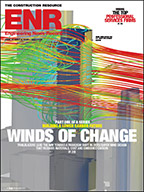In an announcement that could jump-start offshore wind development along the Atlantic seaboard, Google and investment firms Good Energies, New York, and Marubeni Corp., Tokyo, said Oct. 12 that they are backing the development of a 350-mile underwater high-voltage DC transmission line from Northern New Jersey to Norfolk, Va.
The line, being developed by Chevy Chase, Md.based Trans-Elect, would provide a transmission backbone linking several different offshore wind farms off the coasts of Virginia, Maryland, Delaware and New Jersey, and add up to 6,000 MW to the Atlantic grid from wind farms. Construction of the first phase of the line, from northern New Jersey to Rehoboth Beach, Del., is estimated to begin in 2013, cost $1.3 billion and be complete by 2016. The total project, in five segments, is expected to cost more than $5 billion and would be complete sometime after 2020.
Without the single line, each offshore wind developer would have to build its own transmission and connection to shore. Bob Mitchell, CEO of Trans-Elect, said in a news conference that the line would save offshore wind developers 17% to 20% per project. Mitchell says that without the project, only a few offshore wind farms would be built. He says that the line would help the Mid-Atlantic states reach their collective goal of 13,000 MW of renewable energy in coming years.
Mitchell says Trans-Elect would use existing HVDC technology to build the line, but that it would push the limits of that technology by having several onramps and offramps onto the line. DC lines can carry electricity for hundreds of miles with little or no loss of electricity, but they typically can have only one onramp and one offramp. Mitchell says that a new, patented technology will allow the line to pick up electricity from several wind farms and deliver it to multiple spots along the coast. Wind farms would feed electricity into the line from platforms, essentially substations, which will convert the AC electricity to DC.
Rick Needham, director of Google’s green business operations, called the project a superhighway for offshore wind farms, and one that would intelligently expand the region’s renewable grid. Needham says that Google’s investment, about one-third of the development start-up costs, was a “calculated risk” that offered attractive returns.
The line is planned to connect to the shore in areas where there is extra transmission capacity to handle wind power, and where fossil-based generation can provide back-up, or reserve, generation for the intermittent wind power. The transmission line could also be used to carry conventional land-based power.
Ratepayers will pay the cost of the line. The Federal Energy Regulatory Commission and PJM Interconnection will separately have to approve the rates for the projects.
Mitchell says that after the initial phase of the development is completed, Trans-Elect expects to be able to finance the rest of the project through debt. An extended version of this story originally appeared on ENR.com.


Post a comment to this article
Report Abusive Comment